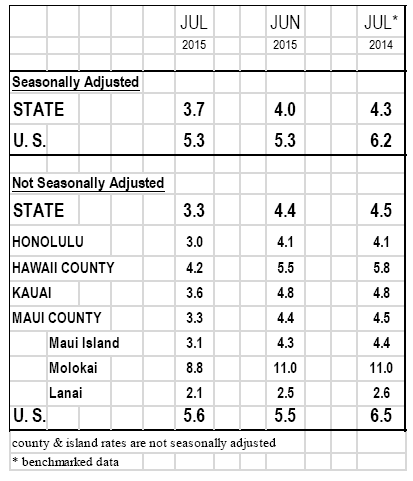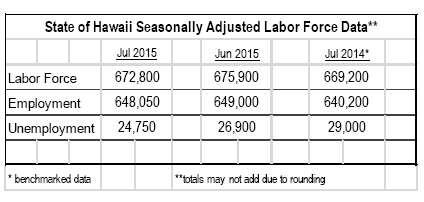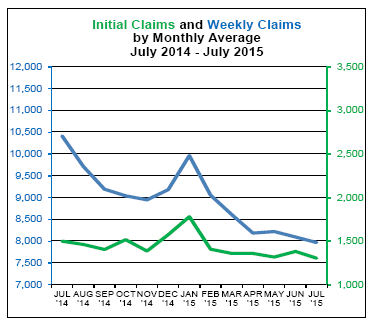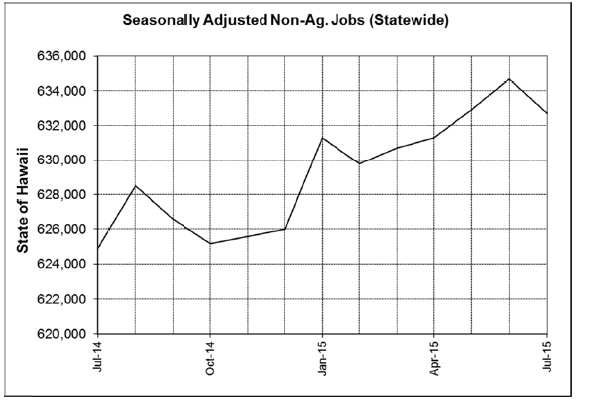DLIR NEWS RELEASE: Hawaii’s Unemployment Rate Drops to 3.7 Percent In July
Posted on Aug 20, 2015 in Latest Department News, Newsroom, Office of the Governor Press ReleasesState’s Lowest Rate Since April 2008
HONOLULU — The Hawaii State Department of Labor & Industrial Relations (DLIR) today announced that the seasonally adjusted unemployment rate for July was 3.7 percent, down from 4.0 percent in June. The last time the seasonally adjust unemployment rate was at or below 3.7 percent was in April 2008 when it was 3.6 percent. Statewide, 648,050 were employed and 24,750 unemployed in July for a total seasonally adjusted labor force of 672,800. Nationally, the seasonally adjusted unemployment rate was 5.3 percent in July, the same as in June.

The unemployment rate figures for the State of Hawaii and the U.S. in this release are seasonally adjusted, in accordance with the U.S. Bureau of Labor Statistics (BLS) methodology. The not seasonally adjusted rate for the State was 3.3 percent in July, down from 4.4 percent in June.

In another measure of employment, total nonagricultural jobs declined by 2,000 in July over June. Among the major industries, there was job expansion in Construction (+400) and Other Services (+300). Job contraction was experienced in Manufacturing (-100), Educational & Health Services (-100), Trade, Transportation, & Utilities (-200), Financial Activities (-200), Leisure & Hospitality (-400), and Professional & Business Services (-900). Government employment decreased by 800 jobs, with losses spread among the three sectors (Local -400, Federal -300, State -100). In comparison with July 2014, there has been an increase of 7,800 total nonagricultural jobs (+1.2%).
Seasonal Adjustment
The seasonal fluctuations in the number of employed and unemployed persons reflect hiring and layoff patterns that accompany regular events such as the winter holiday season and the summer vacation season. These variations make it difficult to tell whether month-to-month changes in employment and unemployment are due to normal seasonal patterns or to changing economic conditions. Therefore, the BLS uses a statistical technique called seasonal adjustment to address these issues. This technique uses the history of the labor force data and the job count data to identify the seasonal movements and to calculate the size and direction of these movements. A seasonal adjustment factor is then developed and applied to the estimates to eliminate the effects of regular seasonal fluctuations on the data. Seasonally adjusted statistical series enable more meaningful data comparisons between months or with an annual average.
Current Population (Household) Survey (CPS)
A survey conducted for employment status in the week that includes the 12th day of each month generates the unemployment rate statistics, which is a separate survey from the Establishment Survey that yields the industry job counts. The CPS survey contacts approximately 1,000 households in Hawaii to determine an individual’s current employment status. Employed persons consist of: 1) all persons who did any work for pay or profit during the survey reference week, 2) all persons who did at least 15 hours of unpaid work in a family-owned enterprise operated by someone in their household, and 3) all persons who were temporarily absent from their regular jobs, whether they were paid or not. Persons considered unemployed are ones that do not have a job, have actively looked for work in the prior four weeks and are available for work. Temporarily laid off workers are counted as unemployed, whether they have engaged in a specific job seeking activity. Persons not in the labor force are those who are not classified as employed or unemployed during the survey reference week.
Benchmark Changes to Local Area Unemployment Statistics Data
Statewide data for 1976-2014 and substate data for 1990-2014 have been re-estimated using a new generation of time series models. See “Report on Revision to State and Area Time-Series Models” at www.bls.gov/lauschanges2015.htm.
Change to Monthly Employment Estimates
This release incorporates revised job count figures from 1990 through 2014 for the seasonally adjusted series. The reconstructed data reflects data from historical corrections applied to unadjusted supersector or sector level series. For years, analysts with the State DLIR’s Research and Statistics Office have developed monthly employment estimates for Hawaii and our metropolitan areas. These estimates were based on a monthly survey of Hawaii businesses and analysts’ knowledge about our local economies. Beginning with the production of preliminary estimates for March 2011, responsibility for the production of State and metropolitan area (MSA) estimates was transitioned from individual state agencies to the U.S Bureau of Labor Statistics (BLS).
For Hawaii, this means the transition of statewide, Honolulu and Kahului-Wailuku-Lahaina MSA areas. State agencies will continue to provide the BLS with information on local events that may affect the estimates, such as strikes or large layoffs/hiring at businesses not covered by the survey and to disseminate and analyze the Current Employment Statistics (CES) estimates for local data users. BLS feels this change is designed to improve the cost efficiency of the CES program and to reduce the potential bias in state and area estimates. A portion of the cost savings generated by this change is slated to be directed towards raising survey response rates in future years, which will decrease the level of statistical error in the CES estimates. Until then, state analysts feel this change could result in increased month-to-month variability for the industry employment numbers particularly for Hawaii’s counties and islands.
Seasonally Adjusted Labor Force and Unemployment Estimates for Honolulu
Effective with the release of metropolitan area data for May 2011, the BLS is publishing smoothed seasonally adjusted civilian labor force and unemployment estimates for all metropolitan areas, which includes the City and County of Honolulu. BLS releases this data each month in the Metropolitan Area Employment and Unemployment news release. The schedule is available at https://www.bls.gov/lau/lausched.htm.
Alternative Measures of Labor Underutilization
Alternative Measures of Labor Underutilization for States, Third Quarter of 2014 through Second Quarter of 2015 Averages.

U-1, persons unemployed 15 weeks or longer, as a percent of the civilian labor force;
U-2, job losers and persons who completed temporary jobs, as a percent of the civilian labor force;
U-3, total unemployed, as a percent of the civilian labor force (this is the definition used for the official unemployment rate);
U-4, total unemployed plus discouraged workers, as a percent of the civilian labor force plus discouraged workers;
U-5, total unemployed, plus discouraged workers, plus all other marginally attached workers*, as a percent of the civilian labor force plus all marginally attached workers; and
U-6, total unemployed, plus all marginally attached workers, plus total employed part time for economic reasons, as a percent of the civilian labor force plus all marginally attached workers.
* Individuals who want, and are available for work, and who have looked for a job sometime in the prior 12 months (or since the end of their last job if they held one within the past 12 months), but were not counted as unemployed because they had not searched for work in the four weeks preceding the survey, for such reasons as child care or transportation problems, for example. Discouraged workers are a subset of the marginally attached.
Note that, the state unemployment rates (U-3) that are shown are derived directly from the CPS. As a result, these U-3 measures may differ from the official state unemployment rates for the latest 4-quarter period. The latter are estimates developed from statistical models that incorporate CPS estimates, as well as input data from other sources, such as state unemployment claims data.
Equal Opportunity Employer/Program
Auxiliary aids and services are available upon request to individuals with disabilities.
TTY/TDD (808) 586-8844
# # #
View DLIR news releases:
https://labor.hawaii.gov/blog/category/news/
Media Contact:
Bill Kunstman
Department of Labor and Industrial Relations
(808) 586-8845
[email protected]



